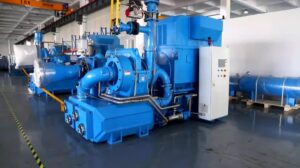Furnace Oil and Lubricants: A Guide to Maximizing Equipment Life
In industries where heavy machinery is the backbone of production, ensuring the longevity and efficiency of equipment is vital. One of the most critical factors in maintaining and extending the life of industrial machinery is proper lubrication and the use of high-quality furnace oil. This guide will provide you with a comprehensive overview of furnace oil and lubricants, highlighting their roles in maximizing equipment life. We’ll also explore how the right choices in fuel oil furnaces, alongside regular maintenance and lubrication, can result in cost savings and enhanced operational efficiency.
What is Furnace Oil?
Furnace oil or furnace fuel oil is a type of fuel oil used predominantly in industrial boilers and furnaces for generating heat. It is a byproduct of crude oil and is highly viscous, requiring preheating before use in equipment. Best oil furnaces has a high calorific value, making it a preferred choice in industries that demand continuous, high-heat operations.
It refers to a unit of the furnace in which fuel fossil is consumed while heat is being transferred. Oil furnaces as well as the natural gas-fueled one are available types. An oil furnace is any heating system used to burn the fuel oil as a means to warm your house. Oil furnaces are, in fact common in colder-weather climates across the northeastern parts of the United States.
Furnace oil is mainly used in industries like power generation, steel, textiles, and chemical processing. Its cost-effectiveness and high efficiency in generating heat make it a popular option in industrial settings.
Key Properties of Furnace Oil:
High Calorific Value: Ensures efficient energy production.
Viscosity: Enables sustained combustion in industrial furnaces.
Stability: Prolongs shelf life and maintains consistent performance.
Typical Performance

How does an oil furnace work?
Types of Furnace Oils
Furnace oils come in different grades, ranging from lighter to heavier variants. The type of furnace oil you choose should depend on your equipment’s specific requirements and the operating conditions. Lighter oils tend to burn more efficiently, while heavier oils may provide a more sustained energy release.
When looking for the best oil furnaces, it’s essential to consider not only the type of oil used but also the furnace’s compatibility with that oil. Modern fuel oil furnace systems are often designed to handle a range of oil types, providing flexibility for industries that rely on varied fuel sources.
What’s the difference between an oil furnace and a gas furnace?
Pros and cons of oil furnaces
Pros:
- High Heat Output: Oil furnaces produce a high level of heat, making them ideal for colder climates where more heating power is needed.
- Independence from Gas Supply: Oil furnaces can operate in areas without access to natural gas lines, providing a reliable heating option.
- Affordable Equipment: The upfront cost of an oil furnace is often lower than other heating systems.
- Longevity: With proper maintenance, oil furnaces can last 15–25 years, offering long-term value.
- Energy Independence: Fuel oil can be stored on-site, giving homeowners control over their fuel supply.
Cons:
- Lower Efficiency: Oil furnaces tend to be less energy-efficient than gas furnaces, often resulting in higher fuel consumption.
- Maintenance Requirements: They require regular upkeep, including cleaning of burners and changing of filters, to prevent soot buildup and maintain efficiency.
- Cost of Fuel: Heating oil prices can fluctuate significantly, making annual heating expenses less predictable.
- Environmental Concerns: Burning oil emits more greenhouse gases compared to natural gas, contributing more to pollution.
- Storage Space: A storage tank for oil is necessary, which can take up significant space and may require periodic inspection and replacement.
Common Uses of Furnace Oil
Furnace oil finds application across various industries due to its reliability and cost-effectiveness:
Power Generation: A primary fuel for thermal power plants.
Industrial Heating: Used in kilns, boilers, and furnaces.
Marine Industry: Powers large engines in ships.
For those seeking reliable furnace oil suppliers in the UAE, the region boasts a robust market catering to industrial and commercial needs.
Fuel Oil Furnace: An Essential Tool for High-Efficiency Heating
A fuel oil furnace is specially designed to burn fuel oil like furnace oil, converting it into heat energy to power industrial operations. These furnaces are highly efficient, especially when the fuel oil is preheated for optimal combustion. Investing in a high-quality fuel oil furnace can help industries maximize energy efficiency while minimizing operational costs.
Role of Lubricants in Equipment Maintenance
While furnace oil is essential for heat generation, lubricants play a crucial role in reducing friction between the moving parts of machinery. Friction is one of the leading causes of equipment wear and tear. By minimizing friction, lubricants help extend the life of equipment, prevent breakdowns, and enhance overall efficiency.
Types of Lubricants Used in Industrial Equipment
- Mineral Oils: These are the most common lubricants derived from refining crude oil. They offer good stability and viscosity and are widely used in various industrial applications.
- Synthetic Oils: Offering better performance than mineral oils, synthetic oils provide improved resistance to oxidation and thermal breakdown, especially in high-temperature environments.
- Greases: These are semi-solid lubricants, often used in applications where liquid oils would leak away, such as in bearings or heavy-load machinery.
Regular use of lubricants prevents metal parts from grinding against each other, which in turn reduces the frequency of repairs and prolongs the life of the machinery.
Best Practices for Selecting the Best Oil Furnace

Choosing the best oil furnaces for your industrial operations involves several critical factors. Selecting the right furnace can have a profound impact on energy consumption, operational costs, and environmental sustainability.
Factors to Consider:
- Energy Efficiency: Opt for an oil furnace with a high Annual Fuel Utilization Efficiency (AFUE) rating. A higher AFUE means more energy is being converted into heat rather than wasted.
- Cost: The upfront cost of a furnace is important, but it’s also crucial to consider long-term operational costs. A cheaper oil furnace may result in higher energy bills and frequent maintenance.
- Size and Capacity: The oil furnace should be appropriately sized for the space it needs to heat. Oversized furnaces waste energy, while undersized ones may not meet operational demands.
- Environmental Impact: Look for oil furnaces that meet modern emissions standards to reduce your carbon footprint. Some modern oil furnaces now come with cleaner burning technology, making them more eco-friendly.
When selecting the best oil furnace, keep in mind your long-term goals in terms of efficiency and sustainability.
The Interplay Between Furnace Oil and Lubricants
Both furnace oil and lubricants play complementary roles in ensuring the longevity of industrial equipment. While furnace oil powers the heat generation process, lubricants ensure that the machinery runs smoothly without excessive wear and tear. The two work together to reduce operational costs and minimize downtime, ultimately enhancing overall productivity.
For example, in a steel plant, where heat generation is a constant necessity, using high-quality furnace oil ensures consistent heat output. At the same time, regular lubrication of the moving parts of the machinery prevents mechanical failures, ensuring that the production line continues without interruptions.
Maintaining Your Oil Furnace for Maximum Efficiency
Proper maintenance of your oil furnace is essential for maximizing its life and operational efficiency. Regular inspections and upkeep will not only extend the lifespan of the furnace but also prevent unexpected breakdowns that could disrupt industrial processes.
Used Oil Furnace Maintenance Tips:
- Regular Inspections: Schedule routine checks for any signs of wear, corrosion, or damage. Inspections will help identify potential issues before they become major problems.
- Clean Fuel Lines: Furnace oil can leave deposits in the fuel lines over time, reducing efficiency. Clean the fuel lines regularly to ensure smooth flow and optimal performance.
- Check for Fuel Leaks: Even small leaks can result in significant losses over time. Ensure that all fuel connections are tight and that no fuel is being wasted.
- Lubricate Moving Parts: Regularly lubricate the blower motor and other moving parts to prevent excessive friction and wear.
Following these best practices will ensure that your used oil furnace operates efficiently and effectively, minimizing downtime and maintenance costs.
Cost Considerations and Furnace Oil Prices
The cost of furnace oil can vary significantly based on factors such as location, crude oil prices, and demand. Monitoring furnace oil prices is critical for businesses relying on this fuel for their operations, as fluctuations in cost can directly impact their bottom line.
Strategies to Manage Furnace Oil Costs:
- Bulk Purchasing: Buying furnace oil in bulk can help lower the price per unit, especially when demand is low.
- Energy Audits: Conduct regular energy audits to identify areas where energy usage can be optimized. This can lead to more efficient use of furnace oil and reduce overall consumption.
- Regular Maintenance: Ensuring your furnace and machinery are in good working order can help prevent inefficiencies that lead to increased fuel consumption.
Investing in high-quality furnace oil and ensuring your equipment is properly maintained can help you avoid the pitfalls of fluctuating oil prices and unexpected equipment failures.
Waste Oil Furnace: A Sustainable Alternative
As industries prioritize sustainability, waste oil furnaces have gained traction. These systems recycle used oils, converting them into usable energy, reducing environmental impact, and lowering operational costs.
Benefits of Waste Oil Furnaces:
Environmental Conservation: Minimizes waste disposal issues.
Cost-Effectiveness: Reuses waste oils effectively.
Energy Efficiency: Provides consistent heating solutions.
Leading Suppliers in the UAE
If you are searching for reliable furnace oil suppliers in UAE the region offers unparalleled options, known for their commitment to quality and timely delivery. Whether it’s furnace oil suppliers in Dubai or other emirates, the UAE stands as a beacon for industrial excellence.
Final Thoughts
Choosing the right furnace oil and lubricants is crucial to maximizing the lifespan of your equipment. Whether you are running a fuel oil furnace or a used oil furnace, the quality of the oil and lubricants you use, combined with a proactive maintenance schedule, will have a significant impact on equipment performance. By staying informed about furnace oil prices and ensuring proper lubrication, businesses can reduce operational costs, prevent breakdowns, and extend the life of their valuable machinery.
FAQs

Which UAE Lubricants manufacturers is Best for High-Mileage Engines?
Which UAE Lubricants manufacturers is Best for High-Mileage Engines? Discover More The sprawling deserts and bustling metropolises of the United Arab Emirates present a uniquely demanding environment for vehicles, pushing engine lubrication technology to its absolute limits. From the scorching summer heat that can cause conventional oils to thin out and lose protective properties, to the endless stop-start traffic of cities like Dubai and Abu Dhabi that promotes sludge and acidic buildup, our cars endure a severe service regimen unlike

What Vehicles Use Kerasene? A Comprehensive Guide
What Vehicles Use Kerasene? A Comprehensive Guide to Fueling Beyond Gasoline Discover More When we think of vehicle fuel, gasoline and diesel immediately come to mind. They are the lifeblood of our daily commutes, the power behind the trucks that deliver our goods, and the standard by which we measure automotive progress. But venture beyond the everyday, into the realms of high-altitude aviation, rugged agricultural machinery, and groundbreaking space exploration, and you’ll discover a different, equally vital fuel that operates

How To Chose Antioxidant Additives in UAE | Industrial Grade Chemicals?
How To Chose Antioxidant Additives in UAE | Industrial Grade Chemicals? Discover More In the heart of a rapidly industrializing region, the United Arab Emirates stands as a beacon of manufacturing, logistics, and heavy industry. From the sprawling automotive workshops of Dubai to the massive petrochemical complexes in Ruwais, the performance and longevity of machinery are paramount. At the core of this operational excellence lies a critical, yet often overlooked, component: industrial lubricants and fluids. These lifeblood substances are constantly

Viscosity Index Improvers UAE – Improve Lubricant Performance
Viscosity Index Improvers UAE – Improve Lubricant Performance Discover More In the heart of the United Arab Emirates, where ambition is matched only by the scale of its infrastructure, the machinery that builds and powers the nation faces a relentless adversary: the climate. The combination of extreme heat, temperature volatility, abrasive dust, and intense UV radiation creates a perfect storm of conditions that relentlessly attack the lifeblood of all mechanical systems—the lubricant. For maintenance managers, plant operators, and fleet owners,

Compressor Oils UAE | Lubricants for Air Compressors
Compressor Oils UAE | Lubricants for Air Compressors Discover More In the relentless engine of the UAE’s economy, where ambition is matched only by the scale of its construction and industry, air compressors are the indispensable workhorses. They are the silent force driving the pneumatic tools that build our skylines, the automated machinery in our factories, the climate control systems in our buildings, and even the processes in oil and gas refineries. Yet, within these critical machines, a component often

How to Chose Best Diesel Engine Oil in UAE for Your Vehicle | Get Quote
Guide to Choosing the Best Diesel Engine Oil in UAE For Your Vehicle Discover More In the United Arab Emirates, the relationship between a driver and their vehicle is forged in fire. The unrelenting sun, the searing asphalt, and the ever-present fine sand create an operating environment that is among the most punishing on Earth. For the diesel engines that power the UAE’s growth—from the rugged Land Cruisers conquering dunes to the Ford F-150s on city streets and the fleets

What Are the Latest Trends in Sustainable Industrial Oils for UAE Manufacturers?
What Are the Latest Trends in Sustainable Industrial Oils for UAE Manufacturers? Discover More Industrial oils form the lifeline of heavy industries, enabling machines, turbines, compressors, and production lines to function seamlessly. They reduce friction, cool equipment, prevent wear, and ensure uninterrupted operations. In a fast-developing economy like the UAE—where energy, petrochemicals, construction, and manufacturing drive growth—industrial oils are indispensable. But today, the conversation around industrial oils is no longer limited to performance. Global concerns about climate change, carbon emissions,

UAE Brake Fluid – DOT 4 vs. DOT 5.1 Which One Should Use
UAE Brake Fluid – DOT 4 vs. DOT 5.1 Which One Should Use Discover More Brake fluid is one of the most critical yet often overlooked components in a vehicle’s braking system. It plays a pivotal role in ensuring that when you press the brake pedal, your car comes to a smooth and controlled stop. In the United Arab Emirates (UAE), where extreme heat, high-speed driving, and heavy traffic are common, selecting the right brake fluid is not just a

What Is a TBN Booster Additive & Why Does Your Engine Need It?
What Is a TBN Booster Additive & Why Does Your Engine Need It? Discover More Engines are the heart of any vehicle, and their longevity depends heavily on the quality of lubrication they receive. Over time, engine oil degrades due to heat, friction, and chemical reactions, leading to acid buildup, sludge formation, and increased wear. To combat these issues, TBN (Total Base Number) Booster Additives play a vital role in maintaining oil stability and engine health. In this guide we’ll explore: What TBN is and why

How Anti-Oxidants in Fuel Additives Can Save You Thousands on Repairs
How Anti-Oxidants in Fuel Additives Can Save You Thousands on Repairs Discover More Every time you start your car, an invisible chemical reaction is taking place that could be costing you hundreds – even thousands – of dollars in unnecessary repairs. Fuel oxidation, the process where gasoline or diesel breaks down when exposed to oxygen, is one of the most overlooked yet destructive forces affecting modern engines. The shocking truth? Studies show that untreated fuel can begin degrading in as